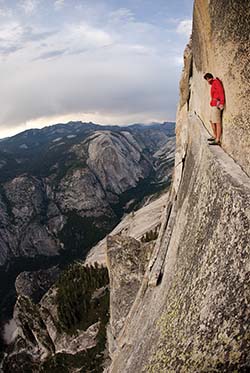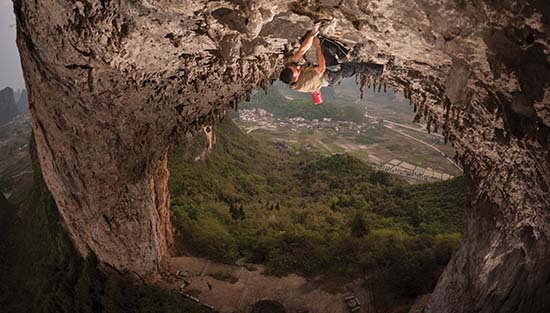 |
 |
| current issue |  |
past issues |  |
send a letter/news |  |
address update |  |
advertise |  |
about us |  |
alumni home |
Going to Extremes
Page 2 of 4
Previous | Next
In 1999, on a summer road trip to Utah, he brought along his new camera—a present to himself purchased with high school graduation money—to chronicle the cross-country adventure. It spawned a complementary avocation. "My first published shots were actually for the student newspaper, The New Hampshire," Kemple says. He received encouraging feedback after submitting images to climbing magazines, and after graduation he continued to climb and make submissions. "I took the conventional route, pitching magazines, trying to get assignments," he says. He got his share, and as the demand for his work grew, Kemple eventually decided he needed to quit pro climbing to completely dedicate himself to photography. "I don't want to say I regret the decision because I don't," he says, "but I do miss it. I miss pushing myself in a purely physical way." Kemple is in his small studio office in Salt Lake City when we talk, his home base when he's not traveling (which is rare) and the place he edits images and video before he sets out again. With his thin, scruffy beard and his black-framed eyeglasses he looks Brooklyn hipsterish. "Right now I'm working on my personal reel," he says. "It's what you show to ad agencies and brands so you can do more cool stuff." With his background in the adventure world, Kemple was a natural for cutting-edge outdoor clients whose brands are linked to the most breathtaking landscapes in the world. He says he doesn't like to "cover" athlete adventurers so much as commune with them. A case in point: in advance of a recent mountain bike assignment, he pedaled for hours on the canyon trails near his home in Salt Lake City, knowing he didn't have the sport "dialed in" and worried that he wouldn't be able to do justice to the culture. "I need to know the community I'm working with so I can portray it as authentically as possible," he says. "Every project, I want to rise to the occasion and bring my special sauce, whatever that is, so I can create something they hadn't seen before." Kemple says he'll never be the guy who has his camera bag carried for him. "It's important to me that I carry my weight and then some. Rather than drag down an expedition, I want to make it better and the athletes' lives more fun." The mad men and women Kemple follows into the mountains like and respect the fact that he is one of them. In Mexico, Tyler Bradt was returning to kayaking after breaking his back on a disastrous waterfall jump. By trip's end Kemple was doing portraiture of the eight-inch surgical scar on his back. "My whole thing is taking shots that will inspire them, too," he says. In the case of Bradt, who holds the world record for the biggest waterfall run in a kayak, the scar picture was a soulful measure of what he'd overcome. "There are photographs that are beautiful, and you look at them once and never come back," says Kemple. "If you knew Tyler, the picture is worth more than one look because it captures him on so many levels. Scars say a lot."
As a former hard-core athlete, Kemple knows the "crux moments" that inspire. He also knows they sometimes mean taking as much risk or more as the folks he's snapping. Earlier this year, in Thorsmork, Iceland (a place named after the Norse god Thor), he chased the right balance of sun and shadows into an otherworldly looking glacial ice cave. He could hear the creaking, ice-fracturing sounds and vividly imagined the whole, water-eroded cave crashing down on top of him. "I thought to myself, 'At least when they find me, they can say my last photograph was a good one.'" He snapped only a few frames before racing out to safety. In the case of the waterfall shot, Kemple knew exactly what he was looking for. He needed to be closer than anyone had ever been, but not so close that the spray kicked up and tainted the image. The rope he clung to was pulled taut by a pulley system and spanned some 100 feet across Tomata Falls. "We've subsequently tried this in other places, but nowhere has it worked so well as there. It was perfect," Kemple says. "The flow of the river was high enough for the kayakers to run, but it wasn't so high that the spray from the waterfall was billowing up into the camera lens. You could actually see the guys go all the way down the falls." |
blog comments powered by Disqus



